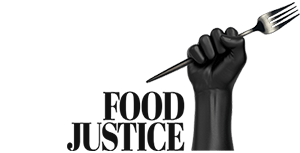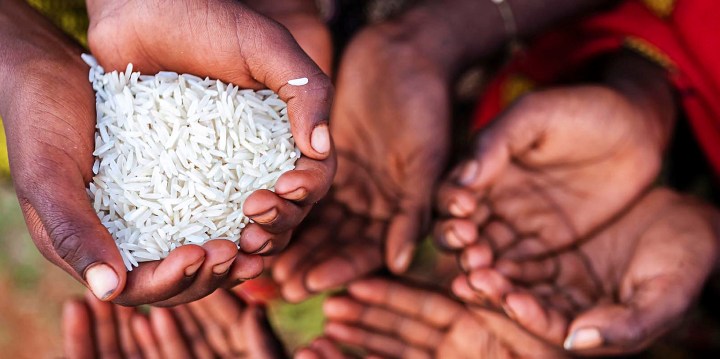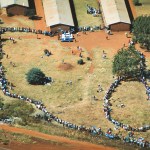
#FOODJUSTICE
Climate crisis exacerbates food insecurity, plan to overcome it remains dormant

The 2018-2023 National Food and Nutrition Security Plan was created to ensure nationwide food security, which South Africa’s Constitution requires when it says ‘everyone has a right to sufficient food’. In the course of our Food Justice investigations, Maverick Citizen has attempted many times to follow up on the creation of the National Food and Nutrition Security Council, which is the Plan’s first objective, to coordinate food policy in South Africa. But it seems we are hitting a wall.
Our most recent attempt was to ask government how it is addressing the urgent issue of food insecurity during the transition to a low-carbon economy. The response restates high-level policy but says almost nothing about what concrete actions the government is taking to improve food security.
In 2020, when Statistics South Africa measured food insecurity in South Africa during the Covid pandemic, at least 9-million people (14.9%) experienced “severe food insecurity” (up from 7% in 2019), and another 14-million people (23.6%) were affected by “moderate to severe” food insecurity (up from 17.3% in 2019).
Food security should mean that all people have physical and economic access to sufficient, safe, nutritious food to meet their dietary needs and food preferences for an active and healthy life.
Food insecurity — when people’s access to food is minimally adequate and they have trouble meeting their basic needs — is a longstanding issue in South Africa and the consequences are devastating on an individual, household and national level.
More than one quarter (27%) of children under the age of five in South Africa are stunted as a result of malnutrition, resulting in lifelong physical and cognitive damage, and overall around 30 million people — half the population — are “food-stressed,” unable to afford enough nutritious food.
W(h)ither the National Food and Nutrition Security Plan?
The National Food and Nutrition Security Plan (“the Plan”) was published in 2017, declaring that its aim was to “combat the silent crisis of malnutrition and reverse its growth in the next 15 years”. The 236-page document is an overarching policy that addresses all aspects of the food system, from farming to what ends up on our plates.
Both the Department of Agriculture, Land Reform and Rural Development (DALRRD), and the Department of Environment, Forestry and Fisheries (DFFE, responsible for “equitable access to land, integrated rural development, sustainable agriculture, and food security for all”) are central to the Plan.
In June this year, Health Outcomes Facilitator for the DPME Thulani Masilela told Maverick Citizen that “the Food and Nutrition Security Technical Committee has consistently been implementing the National Food and Nutrition Security Plan since 2018 and reporting to Cabinet”.
Those reports, however, which Masilela described as “quarterly internal progress reports,” are not in the public domain. More than four years into the Plan’s first five-year term, the formation of the National Food and Nutrition Security Council (NFNSC), a “single leadership and governance structure” to which all government departments are accountable and is the Plan’s first objective, has not yet been convened.
Given its importance, the Plan is housed within the Office of the Presidency and the DPME is overseeing the Plan’s implementation. Its first objective was to create the NFNSC. However, several years later the Council has not yet been formed or convened, and despite assurances from the DPME that the Plan is being implemented, the fact that there are still millions of chronically hungry and otherwise malnourished people in South Africa tells a different story.
One not-insignificant obstacle is the fact that the Plan, budgeted at R86.8 billion, as of June 2022 had not yet been funded. More than three-quarters of the budget (78.2%, or R67.8-billion) is for the mammoth task of agricultural and food supply-chain reform, detailed in the recently-approved Agriculture and Agro-processing Master Plan.
On September 26, 2022, Maverick Citizen published two articles exploring how South Africa can achieve food security with low-carbon methods, in the context of three major factors: First, the shocking levels of food insecurity in South Africa; second, the Agriculture and Agro-processing Master Plan (AAMP), which aims to transform the agriculture and agro-processing sector, increase food security in South Africa, create “decent and inclusive employment”, and enhance competitiveness; and third, the newly approved ‘Just Transition Framework’, which is a blueprint for South Africa’s shift to a low-carbon economy, but which does not deal explicitly with the non-agricultural aspects of the food system. (The “food system” describes all the entities, systems and processes involved in food production, transportation, wholesaling and retailing, as well as the policy environment and cultural norms that influence nutrition, food, health, community development and agriculture.)
Read Part 1 in Daily Maverick: South African food systems and climate change – is low-carbon food security pie in the sky?
Read Part 2 in Daily Maverick: SA food systems and climate change — In search of the Just Food Transition.
In the course of research for these articles, Maverick Citizen had put questions to the National Food and Nutrition Technical Task Team on how it is directly addressing the urgent issue of food insecurity, alongside introducing low-carbon measures. The Task Team is a working group made up of representatives from several different government departments that — according to a spokesperson from the Department of Planning, Monitoring and Evaluation (DPME) — is working on implementing the Plan.
The DPME referred our questions to the Department of Agriculture, Land Reform and Rural Development (DALRRD), promising Maverick Citizen a “comprehensive and specific answer”. (DALRRD is responsible for the Plan’s second objective, to “establish inclusive local food-value chains to support access to nutritious and affordable food”, which is also the second ‘track’ in the new agriculture plan, the AAMP.)
However, DALRRD’s response, which reached us on September 26 — too late for publication in the articles about a low-carbon food system — is anything but “specific”, speaking in broad, non-specific terms about DALRRD’s “commitment to supporting agricultural producers”, and “deliberate efforts … being made towards increasing domestic food production now more than ever before”.
Visit Daily Maverick’s home page for more news, analysis and investigations
The answer sheds little light on any concrete actions the national government is taking to alleviate food insecurity – apart from the Presidential Employment Stimulus Initiative (PESI) which DALRRD says has supported 51,559 subsistence farmers who intend to remain self-employed in agriculture.
What the September 26, 2022 response from DALRRD says about the Agriculture and Agri-processing Master Plan:
- A “new approach” to the implementation of the Agriculture Master Plan “will be kickstarted in the 2023/2024 financial year”;
- The Director-General of DALRRD has approached “relevant national departments to provide detailed implementation plans for their role in the AAMP”, but a comprehensive implementation plan can only be provided “after full participation of all role players … and after Cabinet approval”;
- “South Africa generally continues to meet food requirements at a national level” but the statement acknowledges that “South African households are still battling with challenges such as unemployment, food prices, unstable household food production, and loss of income”; and
- Programmes that DALRRD is implementing “can only be effective if rural households have means of production such as better access to land for increased agricultural production that is expandable to commercial level” and that “expansion of farmland and accelerating land redistribution is critical towards strengthening the agricultural sector”.
What the DALRRD response says about the National Food and Nutrition Security Plan:
- “Support is maximised to producers, in order to ensure that the agricultural land is fully utilised — this will lead to continued food production and sustainable food systems”;
- “Support provided is also/will lead to maximised food efficiency through the value chain”; and
- “Nutrition-specific interventions are identified to address the immediate needs of the nutritionally vulnerable as well as those who require sustained efforts in order to achieve impacts on health — this takes into account dietary requirement issues.”
The DALRRD response gives no concrete details given about the type of support and specific interventions that will be provided, their cost, and, critically, their impact.
Because DALRRD answered only the agriculture aspect of our question, regarding support to small-scale farmers, on September 27 we reposed the original question relating to urgent food insecurity to the DPME, asking also whether the Plan has been funded. By the time of publication, we had not yet received a response from DPME.
Maverick Citizen also asked a range of food-security experts and advocates for their views on DALRRD’s statement.
“All around the world,” food-systems researcher Brittany Kesselman said, “there are examples of governments taking the right to food seriously, putting in place social security nets, undertaking land reforms, prioritising procurement from small-scale farmers, serving nutritious school meals to children, taxing unhealthy foods (like our sugar-sweetened beverage tax) and subsidising healthy ones, providing infrastructure for farmers’ markets and using city planning to improve food access. South Africa has done a few of these things, but there is still a long way to go for the right to food to be realised.
“There is a need for urgent transformation of the structural inequities of the food system,” Kesselman added. Describing the South African food system as “complex and unjust”, she said, “It both reflects and exacerbates inequality, with a few large companies dominating almost every node of the food value chain from agricultural inputs through to storage, processing and retail, making large profits while the majority of the population struggles to access sufficient nutritious food.”
The changes that would have a positive impact on food security go well beyond the mandate of DALRRD, Kesselman said, and require a coordinated effort by many different government departments (exactly what the Council is supposed to be doing). “Access to land and support for small-scale farmers are part of the solution, but by no means all of it,” she told Maverick Citizen.
Charles Simane of the Climate Justice Charter Movement told Maverick Citizen that the Agriculture and Agri-Processing Master Plan “does not prioritise small-holder farmers. Instead, it cements the monopoly of large-scale agribusiness over food systems,” he said.
“It does not appreciate that the hunger crisis is a structural and systemic crisis,” nor the impacts of the climate crisis on our food system, he said. When the AAMP was drafted it took “a top-down approach that ignored the tacit knowledge of small-holder farmers,” Simane said. What is needed for South Africa to achieve long-term food security, he told Maverick Citizen, is an agricultural master plan that focuses on “building food sovereignty pathways” in rural areas, towns and cities. (This would mean that at these levels, people could control how food is produced and distributed.)
Economist Simon Roberts, a professor at the University of Johannesburg, highlighted “the urgent need for leadership on sustainable agriculture and food security, as we can see the impacts of climate change around the world accelerating.” In April this year, Roberts wrote in these pages that “[c]limate change requires rapid, major and systemic economic changes at the local, national and global levels. Food supply is estimated to account for about a third of greenhouse gas emissions.” It is critical, he told Maverick Citizen, to make investments in irrigation, transport, storage and logistics, “especially to support sustainable production by smaller farmers.” DM/MC
NOTE:
The six strategic objectives of the National Food and Nutrition Security Plan (defined in 2017) are:
- The creation of the National Food and Nutrition Security Council, which will be responsible to coordinate, convene and oversee everything that happens in objectives two through six;
- Focus on “local food value chains”, including smallholder farmers, markets, agricultural productivity, processing and waste;
- Expanding social-protection measures and sustainable livelihood programmes;
- Scaling up “high-impact nutrition interventions targeting women, infants and children”;
- Influencing children and adults “to make informed food and nutrition decisions” using “an integrated communications strategy”; and
- Developing a monitoring and evaluation system for food and nutrition security so that progress against the Plan can be measured.
16 October is World Food Day and Maverick Citizen will be publishing articles throughout the week in commemoration of this which will culminate in a special newsletter on Friday 14 October.




















 Become an Insider
Become an Insider
Comments - Please login in order to comment.